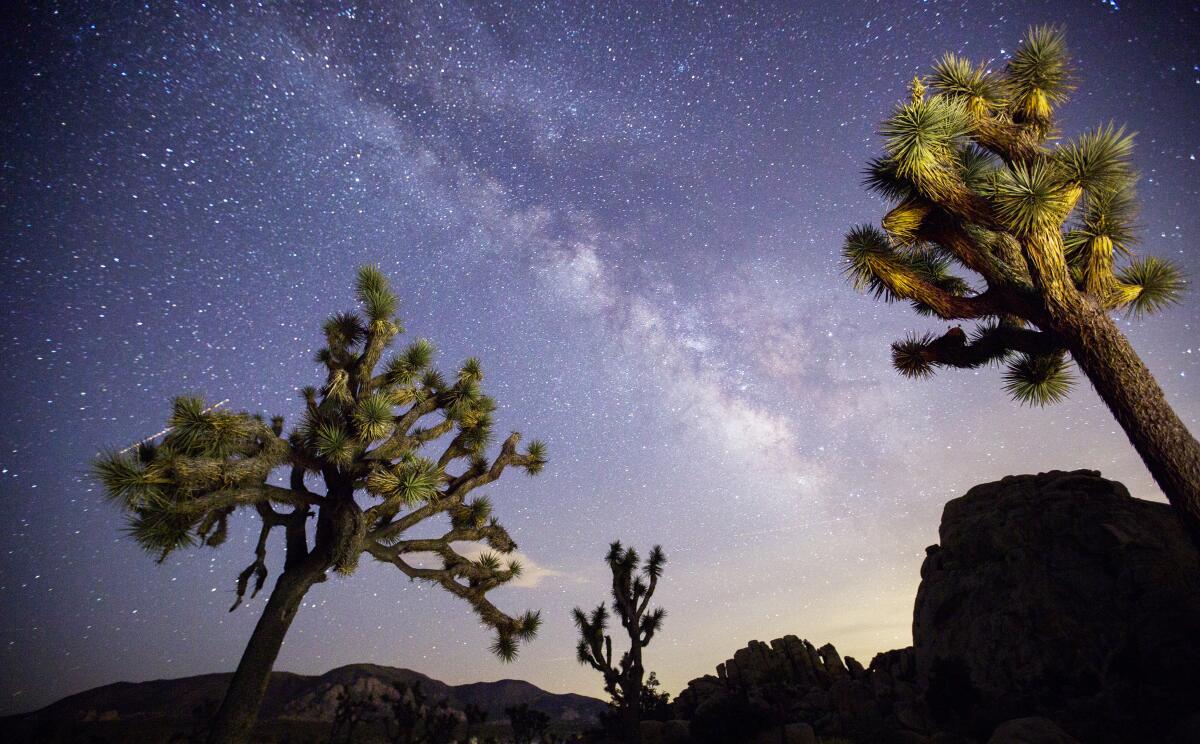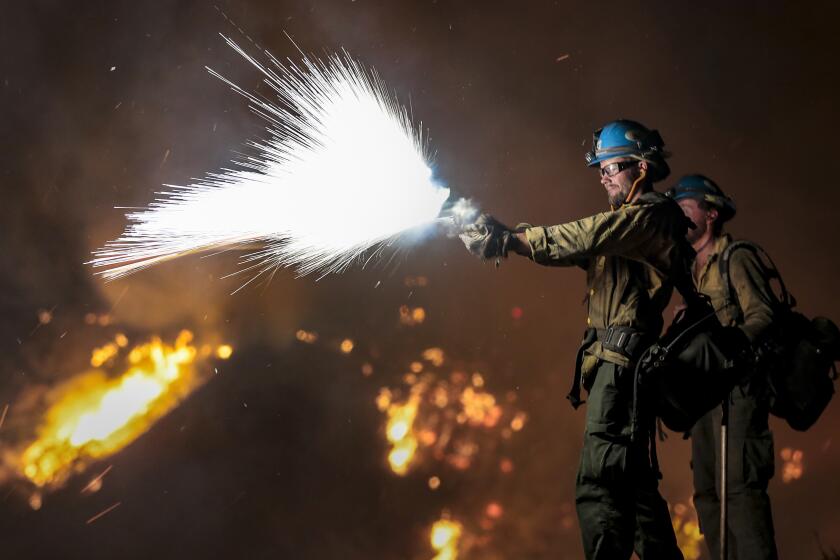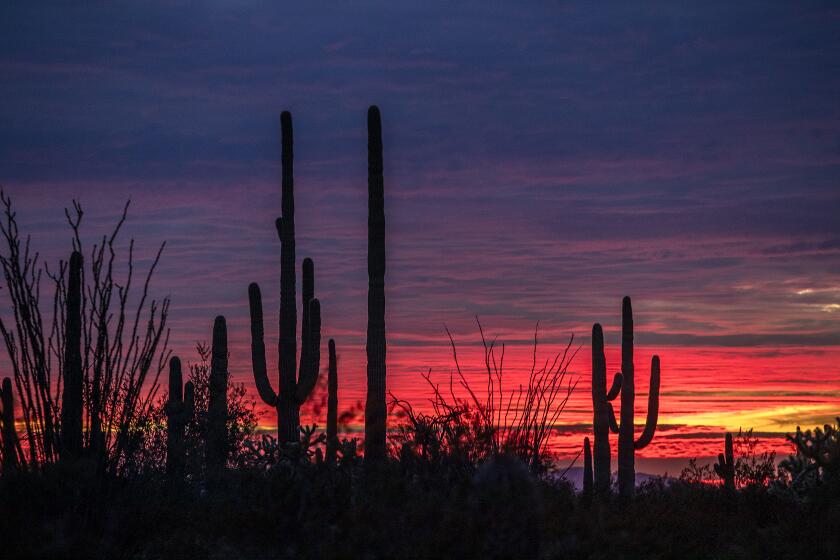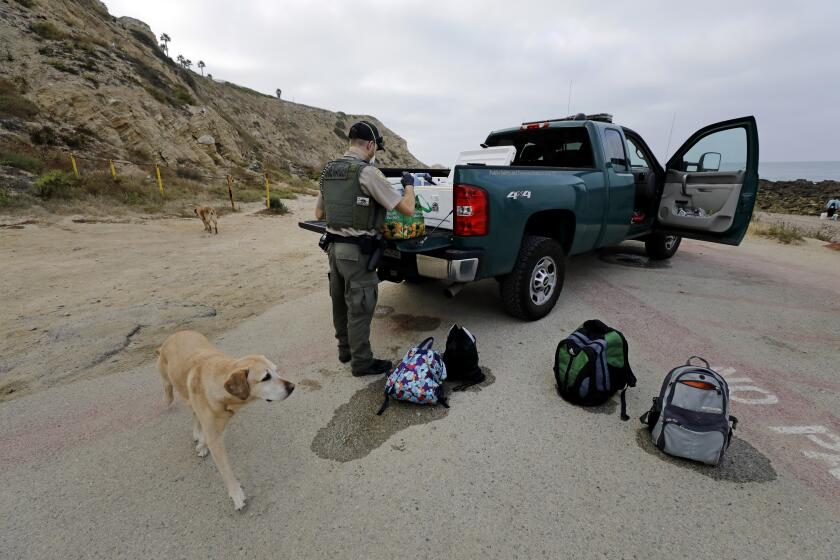California grants western Joshua trees temporary endangered species protections

- Share via
State officials took the unusual step Tuesday of granting temporary endangered species status to the western Joshua tree, but will allow 15 solar energy firms to raze Joshua trees that stand in the way of their shovel-ready projects.
The California Fish and Game Commission’s action reflects a difficult reality: Climate change represents a clear threat to both public health in California and to the long-term sustainability of the western Joshua tree.
The protection came with the panel’s 4-0 decision to consider a petition filed by environmentalists seeking endangered species status for the sensitive desert species. Supporters claim that Yucca brevifolia faces the threat of extinction due to climate change, wildfires and habitat destruction from urban sprawl.
As a candidate for listing, a species is typically afforded the same protections as a state endangered or threatened species pending a final decision.
Fears of a significant spread of the Bobcat fire dissipated as Santa Ana winds failed to materialize, but foothill communities remain on high alert.
Opponents of the petition filed by the Center for Biological Diversity warned that listing Joshua trees could possibly derail or delay solar energy projects designed to help meet California’s climate change goals by shifting the state’s electricity system entirely off fossil fuels by 2045.
On Tuesday, Brendan Cummings, conservation director for the center, told the commissioners he could “grudgingly live with the results” of their decision to devise an “emergency rule” granting exemptions to the solar energy firms.
“Given the climate threat to Joshua trees,” Cummings said, “a rapid transition to 100% energy generation is an essential part of any conservation strategy for the species. But that cannot mean they are given carte blanche to site their projects irrespective of impacts on protected species.”
“Avoidance would be a better policy,” he added. “If you have to mow down hundreds, perhaps thousands, of climate-threatened trees, and disturb carbon-sequestering soils, to build you climate-friendly project — that’s a pretty good indication you’ve put it in the wrong place.”
Shannon Eddy of the Large-scale Solar Assn. would not go that far.
“Regulating by emergency rule should not become the norm,” he said. “The projects in question are urgently needed.”
The plants, sacred to Arizona’s Tohono O’Odham nation, have been chopped down. Federal officials say that most of the affected saguaros have been ‘carefully transplanted.’
As part of an effort to allow the projects to move forward and stay on track with contracted construction schedules in 2021 and 2022, the commissioners established a Western Joshua Tree Mitigation Fund to receive fees to be used to offset the impacts of the 15 solar projects in San Bernardino and Kern counties.
The fee for each project was set at about $10,000 per acre to be mitigated. The money will be used to buy and permanently preserve western Joshua tree habitat.
The petition argues that California will see more frequent and intense droughts and floods as a result of a warming climate, as well as increasing extreme heat days, increased wildfire intensity, worsening air quality and higher electricity demand as a result of these same issues. These effects will combine with other factors to reduce the survivability of Joshua trees, they say.
The low productive rate of the western Joshua tree may not allow it to expand into any new available habitat. This circumstance, state wildlife authorities said, combined with the potential decline of the moths the spindly trees rely on for natural pollination, casts doubt on their future survival.
NASA has nominated the nuclear-contaminated Santa Susana Field Laboratory for listing in the National Register of Historic Places.
A final decision by the commission is expected next year. If the trees are formally listed, the law requires state wildlife managers to devise a recovery plan, which could limit development on private property in communities across thousands of acres of southeastern California’s sunniest real estate.
About 40% of the western Joshua tree’s range is on private land where a state endangered species law would apply, according to the petition, and includes the cities of Palmdale, Lancaster, Hesperia, Victorville and Yucca Valley.
Extensive harvesting of marine life at San Pedro’s White Point Beach has ‘decimated’ the ecosystem, says Los Angeles City Atty. Mike Feuer.
Supporters of the petition include Sen. Dianne Feinstein (D-Calif.) and environmental organizations led by Sierra Club California, the Hispanic Access Foundation, Vet Voice Foundation National Parks Conservation Assn. and Native American Land Conservancy.
Opponents included the San Bernardino County town of Yucca Valley, whose town council denounced the petition as unnecessary because the trees are already protected under city and county ordinances and within the nearby 800,000-acre Joshua Tree National Park.
The commission said it has engaged in collaborative discussions with San Bernardino County about the possibility of granting conditional removal permits for specific routine, small-scale local government-authorized projects.
It was not the first time that wildlife authorities have agreed to exemptions for the renewable energy industry. In a 2013 decision condemned by environmentalists, the U.S. Fish and Wildlife Service said operators of Terra-Gen Power’s wind farm in the Tehachapi Mountains would not be prosecuted if their turbines accidentally killed any federally endangered California condors during the expected 30-year life span of the project.
The western Joshua tree has a boomerang-shaped range stretching from Joshua Tree National Park westward along the northern flanks of the San Bernardino and San Gabriel Mountains, northward along the southern Sierra Nevada range and eastward to the edges of Death Valley National Park and into Nevada.













